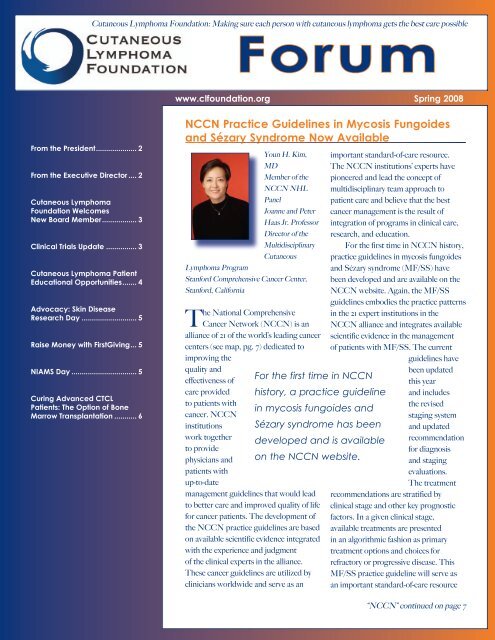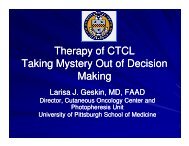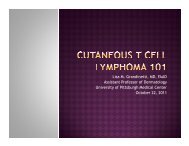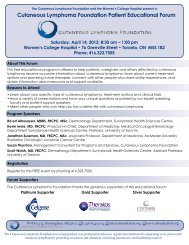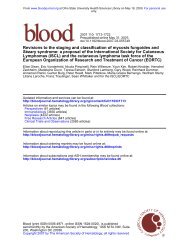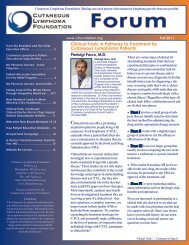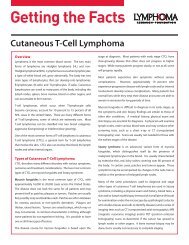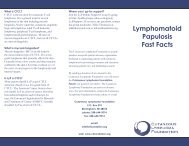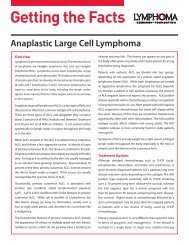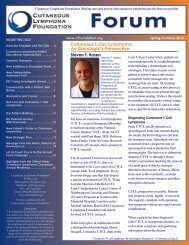Download PDF - Cutaneous Lymphoma Foundation
Download PDF - Cutaneous Lymphoma Foundation
Download PDF - Cutaneous Lymphoma Foundation
Create successful ePaper yourself
Turn your PDF publications into a flip-book with our unique Google optimized e-Paper software.
<strong>Cutaneous</strong> <strong>Lymphoma</strong> <strong>Foundation</strong>: Making sure each person with cutaneous lymphoma gets the best care possible<br />
Forum<br />
www.clfoundation.org Spring 2008<br />
From the President .................... 2<br />
From the Executive Director .... 2<br />
<strong>Cutaneous</strong> <strong>Lymphoma</strong><br />
<strong>Foundation</strong> Welcomes<br />
New Board Member ................. 3<br />
Clinical Trials Update ............... 3<br />
<strong>Cutaneous</strong> <strong>Lymphoma</strong> Patient<br />
Educational Opportunities ....... 4<br />
Advocacy: Skin Disease<br />
Research Day ........................... 5<br />
Raise Money with FirstGiving ... 5<br />
NIAMS Day ................................ 5<br />
Curing Advanced CTCL<br />
Patients: The Option of Bone<br />
Marrow Transplantation ........... 6<br />
NCCN Practice Guidelines in Mycosis Fungoides<br />
and Sézary Syndrome Now Available<br />
Youn H. Kim,<br />
MD<br />
Member of the<br />
NCCN NHL<br />
Panel<br />
Joanne and Peter<br />
Haas Jr. Professor<br />
Director of the<br />
Multidisciplinary<br />
<strong>Cutaneous</strong><br />
<strong>Lymphoma</strong> Program<br />
Stanford Comprehensive Cancer Center,<br />
Stanford, California<br />
The National Comprehensive<br />
Cancer Network (NCCN) is an<br />
alliance of 21 of the world’s leading cancer<br />
centers (see map, pg. 7) dedicated to<br />
improving the<br />
quality and<br />
effectiveness of<br />
care provided<br />
to patients with<br />
cancer. NCCN<br />
institutions<br />
work together<br />
to provide<br />
physicians and<br />
patients with<br />
up-to-date<br />
management guidelines that would lead<br />
to better care and improved quality of life<br />
for cancer patients. The development of<br />
the NCCN practice guidelines are based<br />
on available scientific evidence integrated<br />
with the experience and judgment<br />
of the clinical experts in the alliance.<br />
These cancer guidelines are utilized by<br />
clinicians worldwide and serve as an<br />
For the first time in NCCN<br />
history, a practice guideline<br />
in mycosis fungoides and<br />
Sézary syndrome has been<br />
developed and is available<br />
on the NCCN website.<br />
important standard-of-care resource.<br />
The NCCN institutions’ experts have<br />
pioneered and lead the concept of<br />
multidisciplinary team approach to<br />
patient care and believe that the best<br />
cancer management is the result of<br />
integration of programs in clinical care,<br />
research, and education.<br />
For the first time in NCCN history,<br />
practice guidelines in mycosis fungoides<br />
and Sézary syndrome (MF/SS) have<br />
been developed and are available on the<br />
NCCN website. Again, the MF/SS<br />
guidelines embodies the practice patterns<br />
in the 21 expert institutions in the<br />
NCCN alliance and integrates available<br />
scientific evidence in the management<br />
of patients with MF/SS. The current<br />
guidelines have<br />
been updated<br />
this year<br />
and includes<br />
the revised<br />
staging system<br />
and updated<br />
recommendation<br />
for diagnosis<br />
and staging<br />
evaluations.<br />
The treatment<br />
recommendations are stratified by<br />
clinical stage and other key prognostic<br />
factors. In a given clinical stage,<br />
available treatments are presented<br />
in an algorithmic fashion as primary<br />
treatment options and choices for<br />
refractory or progressive disease. This<br />
MF/SS practice guideline will serve as<br />
an important standard-of-care resource<br />
“NCCN” continued on page 7
<strong>Cutaneous</strong> <strong>Lymphoma</strong> <strong>Foundation</strong><br />
From the President<br />
As I watch the flowering<br />
trees bloom, the grass turn<br />
green and the new shoots of<br />
budding plants push through<br />
the ground, I know that spring<br />
has come to Michigan. It is a<br />
time of new growth and possibilities.<br />
I remember when we<br />
held our first patient educational forum and thinking it<br />
would be wonderful if we could do this every year. Since<br />
January, we have held seven educational forums. Before<br />
the year ends, we will have held four, maybe five more.<br />
When I started the listserv over 10 years ago, the only<br />
people that used the internet were computer nerds. We<br />
still have some of them that are with us 10 years later. As<br />
the internet grew and became more widely available, it<br />
has opened up a new world of information and support<br />
for everyone. We have grown to over 1,000 subscribers<br />
from over 20 different countries.<br />
We held a CTCL Teleconference in collaboration<br />
with CancerCare and the <strong>Lymphoma</strong> Research<br />
<strong>Foundation</strong> last month that attracted over 600 people.<br />
Even more will be able to listen to it by going to our<br />
website at www.clfoundation.org and clicking on<br />
“Educational Opportunities.” Who could have imagined<br />
that it was possible to have that many people interested in<br />
listening to physicians discuss cutaneous lymphoma?<br />
Our website had over 4,000 visits from 66 different<br />
countries in the month of April! When I look at the map<br />
of where these people are coming from, it is obvious that<br />
the only areas that we are not reaching patients are areas<br />
that don’t have a lot of internet access. The possibility of<br />
information being so widely disseminated ten years was<br />
inconceivable.<br />
In 1999 and 2000, the first new treatments in ten<br />
years were FDA approved for CTCL (Ontak and<br />
Targretin). It took eight years before the next treatment<br />
(Zolinza) came on the market. This year we may see<br />
another two treatments come up for approval and many<br />
others are in clinical trials. The timeline for new possible<br />
treatments has increased tremendously.<br />
The possibilities are endless. Up to this point, we<br />
have not discussed the possibility of a cure, but with the<br />
amount of research and new<br />
discoveries in the medical community,<br />
maybe it’s not outside<br />
the realm of possibilities.<br />
From the Executive Director<br />
Having now participated<br />
in my first two Patient<br />
Educational Forums, I can<br />
definitely say that it is great to<br />
again be involved in patient programs.<br />
As previously reported, I<br />
spent the first two months<br />
in my new position meeting<br />
numerous physicians and learning<br />
about cutaneous lymphomas. More recently, I attended<br />
Patient Educational Forums in Chicago, Illinois and<br />
Toronto, Ontario and joined members of the Coalition of<br />
Skin Diseases in Washington, meeting with members of<br />
Congress to push for additional research funding for the<br />
National Institutes of Health (NIH). I found the Patient<br />
Educational Forums to be stimulating and the time spent<br />
talking with the patients, family members and physicians<br />
in attendance served to reinforce my understanding<br />
about the value of the work of the <strong>Cutaneous</strong> <strong>Lymphoma</strong><br />
<strong>Foundation</strong>.<br />
During my career I have been involved with numerous<br />
patient programs including cardiac surgery, bone<br />
marrow transplant, hemodialysis, trauma centers and<br />
many community based primary care programs. I neither<br />
observed in those programs the kind of candid two way<br />
dialogue between physicians and patients that I experienced<br />
at the <strong>Cutaneous</strong> <strong>Lymphoma</strong> Patient Educational<br />
Forums, nor have I encountered groups of patients as<br />
well informed about their disease or as supportive of one<br />
another and willing to share information and experiences<br />
as the patients attending the forums and those interacting<br />
with one another using the <strong>Foundation</strong>’s various communication<br />
channels.<br />
Less exciting but equally important was the time<br />
spent in Washington meeting with members of Congress<br />
and their staffs to discuss government funding levels for<br />
research. Specifically, the discussions focused on increasing<br />
dollars for the National Institutes of Health (NIH)<br />
whose funding (after accounting for inflation) has essentially<br />
been flat for a number of years. The good news is<br />
that both members of the House and Senate have put<br />
forth bills that would mean a real increase in funding for<br />
NIH. Although the President has indicated his opposition<br />
to such an increase, the outcome will depend on the<br />
ultimate conclusion of what<br />
appears to be a difficult federal<br />
budget process.<br />
2 The <strong>Cutaneous</strong> <strong>Lymphoma</strong> <strong>Foundation</strong> Forum is made possible by an unrestricted educational grant from Eisai
Forum, Spring 2008<br />
Forum<br />
The newsletter of the <strong>Cutaneous</strong> <strong>Lymphoma</strong> <strong>Foundation</strong><br />
ALL RIGHTS RESERVED<br />
DESIGNER & EDITORIAL DIRECTOR<br />
Amanda L. J. Kik<br />
MEDICAL EDITOR<br />
Stuart Lessin, M.D.<br />
<strong>Cutaneous</strong> <strong>Lymphoma</strong> <strong>Foundation</strong> is a 501(c)(3)<br />
non-profit organization. Donations are tax deductible<br />
to the extent allowed by law.<br />
SCIENTIFIC ADVISORY BOARD<br />
Thomas Anderson, M.D. University of Michigan<br />
Kevin Cooper, M.D.<br />
Madeleine Duvic, M.D.<br />
Francine Foss, M.D.<br />
Lars French, M.D.<br />
Sam Hwang, M.D., Ph.D.<br />
Robert Knobler, M.D.<br />
Thomas Kupper, M.D.<br />
Liliane Laroche, M.D.<br />
Stuart Lessin, M.D.<br />
Sue McCann, MSN, RN<br />
Lauren Pinter-Brown, M.D.<br />
Pierluigi Porcu, M.D.<br />
David Ramsay, M.D.<br />
Alain Rook, M.D.<br />
Steven T. Rosen, M.D.<br />
Marianne Tawa, MSN, RN, ANP<br />
Martin Weinstock, M.D., Ph.D.<br />
Sean Whittaker, M.D., MRCP<br />
Lynn Wilson, M. D., MPH<br />
Case Western Reserve University<br />
MD Anderson Cancer Center<br />
Yale University School of Medicine<br />
Geneva Medical Center<br />
National Institutes of Health<br />
University of Vienna<br />
Brigham and Women’s Hospital<br />
University of Paris<br />
Fox Chase Cancer Center<br />
University of Pittsburgh Medical Center<br />
UCLA Medical Center<br />
Ohio Sate University<br />
New York University<br />
University of Pennsylvania<br />
Northwestern University<br />
Dana Farber Cancer Institute, Boston<br />
Brown University<br />
Guys & St. Thomas Hospital<br />
Yale University School of Medicine<br />
<strong>Cutaneous</strong> <strong>Lymphoma</strong> <strong>Foundation</strong><br />
PO Box 374<br />
Birmingham, MI 48012-0374<br />
telephone: (248) 644-9014<br />
fax: (248) 644-9014<br />
email: info@clfoundation.org<br />
www.clfoundation.org<br />
Forum is published by the<br />
<strong>Cutaneous</strong> <strong>Lymphoma</strong> <strong>Foundation</strong>.<br />
Because each person’s body and response to treatment is<br />
different, no individual should indulge in self-diagnosis<br />
or embark upon any course of medical treatment that is<br />
described in Forum without first consulting with his or<br />
her physician.<br />
<strong>Cutaneous</strong> <strong>Lymphoma</strong> <strong>Foundation</strong> is not responsible for<br />
the medical care or treatment of any individual.<br />
<strong>Cutaneous</strong> <strong>Lymphoma</strong> <strong>Foundation</strong><br />
Welcomes New Board Member<br />
The <strong>Cutaneous</strong> <strong>Lymphoma</strong> <strong>Foundation</strong> welcomes a new leader<br />
to the Board of Directors.<br />
A native of Philadelphia, Susan Thornton has been in the health<br />
care information technology field for the last 24 years in various<br />
consulting, sales and marketing<br />
positions, and is currently working<br />
for Draeger Medical as the IT<br />
Solutions Marketing Manager for<br />
their anesthesia and intensive care<br />
software solutions. In addition to<br />
her professional career in health care<br />
technology, Susan has been active<br />
in many non-profit organizations<br />
in the Philadelphia region, holding<br />
Board positions at the Eastern<br />
Pennsylvania Chapter of the Sierra<br />
Club, The Leukemia & <strong>Lymphoma</strong> Society Eastern PA Chapter<br />
and was one of the original members of the Tristate Multisport<br />
Association. Susan’s love of sports, in particular triathlons, has<br />
given her the opportunity to coach with the local Team in Training<br />
triathlon teams, become Race Director for the Patriot’s Triathlon<br />
and mentor many beginning triathletes. Susan holds a Marketing/<br />
Management degree from the University of Pennsylvania’s Wharton<br />
School and recently completed the Fundraising Certification<br />
Program at the University of Pennsylvania. ✹<br />
Clinical Trials Update<br />
You may find clinical trials listed on www.clfoundation.org<br />
(click on “Clinical trials”). The three listed here are recent<br />
updates:<br />
The first is open for patients of all stages of disease. The<br />
drugconsists of a diphtheria toxin which is attached to an antibody<br />
that can specifically target cancerous T-cells. This trial<br />
is currently only available in Texas, but enrolled patients will<br />
receive full supportive stay (including travel and lodging). For<br />
more information about this trial, call Dr. Arthur Frankel, 254-<br />
724-4469.<br />
The second trial is a stem cell transplant study for patients<br />
with advanced disease, and is being conducted at the National<br />
Institutes of Health (NIH). To obtain more information and<br />
to find out if you qualify, call 1-800-411-1222.<br />
The third is evaluating the effectiveness of topical romidepsin<br />
(depsipeptide) in patients with early-stage CTCL. Romidepsin<br />
has already shown to be effective in treating CTCL in some<br />
patients with later stages of the disease. For additional information,<br />
contact Susan L. Booher, R.N. at NCI, 301-402-1474.<br />
3
<strong>Cutaneous</strong> <strong>Lymphoma</strong> <strong>Foundation</strong><br />
<strong>Cutaneous</strong> <strong>Lymphoma</strong> Patient Educational Opportunities<br />
September 26, 2008: San Francisco<br />
North American Educational<br />
Forum on <strong>Lymphoma</strong>, presented<br />
in partnership with the <strong>Lymphoma</strong><br />
Research <strong>Foundation</strong>.<br />
October 18: Minneapolis, MN<br />
<strong>Lymphoma</strong> Workshop, presented<br />
in partnership with the <strong>Lymphoma</strong><br />
Research <strong>Foundation</strong><br />
Dr. Steven Rosen and Dr. Christiane Querfeld at the Chicago<br />
<strong>Cutaneous</strong> <strong>Lymphoma</strong> Patient Educational Forum.<br />
October 25: Pittsburgh, PA<br />
11th Annual Brian V. Jegasothy<br />
Support Group for CTCL, presented<br />
in partnership with the University of<br />
Pittsburgh Medical Center<br />
Lynne Wagner, PhD speaks at the Chicago <strong>Cutaneous</strong><br />
<strong>Lymphoma</strong> Patient Educational Forum.<br />
November 8: Brooklyn, NY<br />
<strong>Lymphoma</strong> Workshop, presented<br />
in partnership with the <strong>Lymphoma</strong><br />
Research <strong>Foundation</strong><br />
A panel of experts speak at the Toronto <strong>Cutaneous</strong><br />
<strong>Lymphoma</strong> Patient Educational Forum.<br />
Patient Educational Forums provide exceptional opportunities for people with cutaneous lymphoma to receive<br />
accurate information about treatment options, access experts in the field and connect with other people with similar<br />
experiences.<br />
<strong>Cutaneous</strong> <strong>Lymphoma</strong> <strong>Foundation</strong> Patient Education<br />
Forums key features:<br />
Half-day to day-long event<br />
Held in cities throughout North America<br />
Professional and lay speakers<br />
Format includes lectures, Q&A sessions and<br />
small-group discussions<br />
Objectives:<br />
• Develop a better understanding of<br />
diagnostic tests.<br />
• Learn about treatments available for<br />
different disease stages.<br />
• Identify resources for treatment and support.<br />
For more information, visit www.clfoundation.org or call (248)644-9014<br />
These educational opportunities are made possible by generous unrestricted educational grants from:<br />
Platinum Sponsors: Eisai Inc., Therakos, & Ovation Gold Sponsor: Merck Oncology Silver Sponsor: Gloucester<br />
4
Forum, Spring 2008<br />
Advocacy: Skin Disease Research Day<br />
April 10, 2008 was a beautiful<br />
day in the nation’s capital with<br />
the cherry blossoms in full bloom as<br />
representatives from the American<br />
Academy of Dermatology, the Society<br />
for Investigative Dermatology and<br />
the Coalition of Skin Diseases met<br />
with members of Congress to discuss<br />
increased funding for the National<br />
Institutes of Health (NIH) and the<br />
cumulative impact of five consecutive<br />
years of inadequate budgetary support.<br />
This situation impacts current research,<br />
threatening advances in medicine and<br />
putting the US at risk of losing both an<br />
entire generation of young researchers<br />
and its global competitive edge. The<br />
<strong>Cutaneous</strong> <strong>Lymphoma</strong> <strong>Foundation</strong><br />
was represented by Executive Director<br />
Gary Ross and Amanda Kik, Director of<br />
Education.<br />
Due to prolonged budget<br />
constraints, the NIH currently<br />
approves only one in four original<br />
research applications it receives. This<br />
practice has two negative effects. First<br />
is a tendency to fund conservative<br />
research applications over more<br />
innovative proposals that might achieve<br />
breakthroughs in combating diseases.<br />
Second is the fact that a growing<br />
backlog of failed applications (NIH<br />
only approved 24 percent of applications<br />
received in 2007) has pushed the average<br />
age of a researcher receiving his or her<br />
first grant from 39 years of age in 1999<br />
to 43 in 2007. This kind of obstacle<br />
will ultimately result in fewer students<br />
pursuing medical research as a career.<br />
This year there is some reason for<br />
optimism regarding research funding<br />
as both the Senate and the House are<br />
proposing increases for NIH in the<br />
pending federal budget. The Senate<br />
approved a Budget Resolution which<br />
contains a $3 billion, or 10.3% increase in<br />
funding to the NIH in fiscal year 2009,<br />
and an overwhelming number (179) of<br />
Representatives are supporting a 6.5%<br />
increase in funding. The message that<br />
the advocates took to the legislators<br />
on April 10 was to support at least a<br />
$1.9 billion or 6.6 percent increase in<br />
funding to the NIH. Based on a Bureau<br />
of Economic Analysis evaluation, this<br />
amount would restore NIH’s purchasing<br />
power and provide for a real 3% increase<br />
in available dollars. A proportional<br />
share of these dollars would be allocated<br />
to skin disease research as part of the<br />
programs of the National Institute of<br />
Arthritis and Musculoskeletal and Skin<br />
Diseases (NIAMS). ✹<br />
Raise Money with FirstGiving<br />
Raise money for the <strong>Cutaneous</strong><br />
<strong>Lymphoma</strong> <strong>Foundation</strong>, the<br />
only organization that supports<br />
patients with mycosis fungoides,<br />
Sézary syndrome and all<br />
forms of cutaneous lymphomas.<br />
Are you having a birthday?<br />
Running a race? Celebrating<br />
a marriage? Would you like<br />
to honor someone? Use<br />
FirstGiving to utilize these<br />
important life events to raise<br />
funds for the important work<br />
of the <strong>Cutaneous</strong> <strong>Lymphoma</strong><br />
<strong>Foundation</strong>.<br />
It is quick and easy to get<br />
started. Simply visit www.<br />
firstgiving.com/CLF, and create<br />
a personalized page. You<br />
can input your story and upload<br />
photos. Then, just send an<br />
email to your friends and family<br />
and watch the funding roll in!<br />
NIAMS Day<br />
In March, the NIAMS Coalition gathered in Washington, DC to submit<br />
testimony to the House Committee on Appropriations in support of<br />
the National Institute of Arthritis and Musculoskeletal and Skin Diseases<br />
(NIAMS).<br />
The NIAMS Coalition is comprised of more than 70 organizations (medical,<br />
patient advocacy and research based) dedicated to advancing the critical<br />
research funded at NIAMS.<br />
The <strong>Cutaneous</strong> <strong>Lymphoma</strong> <strong>Foundation</strong> (represented by Judy Jones,<br />
President) and the Coalition of Skin Diseases urged Congress to support an<br />
increase in funding for the National Institutes of Health (NIH) and NIAMS.<br />
If NIAMS does not get consistent funding, the nation risks losing the promising research that is so important to finding<br />
cures and providing more effective, lower cost therapies and treatments. Because cutaneous lymphomas are a rare disease,<br />
this is especially important for our patients, caregivers and medical professionals.<br />
5
<strong>Cutaneous</strong> <strong>Lymphoma</strong> <strong>Foundation</strong><br />
6<br />
Curing Advanced CTCL Patients: The Option of Bone Marrow Transplantation<br />
Dr. Madeleine<br />
Duvic is Professor<br />
and Deputy Chair<br />
of the Department<br />
of Dermatology<br />
at the University<br />
of Texas MD<br />
Anderson Cancer<br />
Center. She has<br />
been a pioneer<br />
in cutaneous T-cell lymphoma research and<br />
sits on the <strong>Cutaneous</strong> <strong>Lymphoma</strong> Medical<br />
Advisory Board.<br />
Stem cell transplants are being used<br />
for a variety of medical conditions<br />
from heart failure to cancer. During the<br />
International Society for <strong>Cutaneous</strong><br />
<strong>Lymphoma</strong>s (ISCL) meeting held in<br />
February, we discussed<br />
the pros and cons of bone<br />
marrow transplantation<br />
for CTCL patients. Dr.<br />
Fred LeMaistre runs a<br />
transplant center in San<br />
Antonio and gave the<br />
keynote address. Other<br />
speakers summarized<br />
their results at other CTCL centers<br />
including Northwestern, Ohio State,<br />
Stanford, and MD Anderson.<br />
Hematopoietic stem cells (HSC)<br />
are present in both the bone marrow and<br />
the blood stream. HSC can be collected<br />
from either source, but obviously the<br />
blood is more accessible with less<br />
discomfort. Bone marrow transplant<br />
refers to using HSC collected from the<br />
bone marrow while peripheral SC are<br />
from blood. HSC are most commonly<br />
used therapeutically for treating patients<br />
with leukemia and lymphomas but<br />
autoimmune diseases and even heart<br />
failure may respond.<br />
An autologous (auto) stem cell<br />
transplant (auto-SCT) uses the patient’s<br />
own stem cells, expands them in culture,<br />
and they are reinfused when the patient<br />
receives high dose chemotherapy.<br />
Allogeneic SCT (allo-SCT) are with<br />
stem cells from another person who<br />
is called a matched donor. Cells all<br />
have marker proteins (called HLA<br />
or MHC antigens) that tell the body<br />
they belong. If you give any kind of<br />
transplant that is not matched it will<br />
be rejected immediately unless high<br />
doses of immunosuppressive therapies<br />
are given. The best match, of course,<br />
is an identical twin. Brothers or sisters<br />
can also be identical to one another and<br />
close matches for HLA antigens. In the<br />
event a related donor is not available,<br />
unrelated donors who are willing to<br />
help are sought from the national donor<br />
database. Failing that, cord blood stem<br />
cells can be used and harvested from the<br />
The point of having a stem cell transplant is<br />
to allow patients to receive very high dose<br />
chemotherapy to get rid of the cancer and<br />
knock out their own bone marrow function.<br />
umbilical cord.<br />
The point of having a SCT is to<br />
allow patients to receive very high dose<br />
chemotherapy to get rid of the cancer<br />
and knock out their own bone marrow<br />
function. Without the transplant, a<br />
patient is at greater risk for a deadly<br />
infection or other complication. In<br />
the past decade, non-ablative SCTs<br />
have been modified. The dose of<br />
chemotherapy is lower and the graft<br />
(donor stem cells) is allowed to slowly<br />
take over the patient’s marrow (called<br />
chimerism – because the patient and<br />
donor co-exist together for a while). This<br />
process is not as dangerous but the price<br />
is a side effect called graft vs host disease<br />
(GVHD). Donor T-cells can attack the<br />
skin, GI tract, liver, lungs, and eyes and<br />
if this is severe can be even worse than<br />
having CTCL in its most severe form..<br />
Luckily, there are immunosuppressive<br />
drugs that can suppress GVHD but<br />
again make the patient more susceptible<br />
to infections. GVHD has a beneficial<br />
effect of killing off some of the tumor<br />
cells.<br />
Having a SCT actually only takes<br />
about 5 minutes. It is exactly like getting<br />
a blood transfusion through a vein. It<br />
is a rescue tool given just following a<br />
week of high dose chemotherapy in<br />
the hospital. SCT rescues the patient’s<br />
immune system. Since CTCL is a<br />
disease of the immune system, replacing<br />
it with another’s system makes good<br />
sense whereas an auto-SCT does not do<br />
as much, although it may improve the<br />
disease for a while.<br />
Which CTCL patients should<br />
consider having a SCT<br />
and what kind? The risk<br />
of death from infection or<br />
graft vs host disease are<br />
real risks, so SCT should<br />
only be discussed when<br />
the CTCL is aggressive<br />
or has progressed to<br />
the point that high dose<br />
chemotherapy is needed. First, we know<br />
that auto-SCT can improve but not<br />
cure CTCL patients and the disease<br />
will come back sooner rather than later.<br />
Secondly, allo-SCT have the potential<br />
to cure CTCL but require a 10/10 HLA<br />
matched donor and a relatively healthy<br />
patient who is able to tolerate high dose<br />
chemotherapy and has a good caregiver<br />
support team. The ideal patient is<br />
young, has at least stage IIB with large<br />
cell transformation soon after diagnosis<br />
or has blood, node or internal disease<br />
such that their median survival estimate<br />
is only 2-3 years. Sézary patients who are<br />
miserable from their disease may also be<br />
appropriate to transplant earlier rather<br />
than later. Since the risk from transplant<br />
procedure includes death from infection<br />
and chronic GVHD, only for a patient<br />
whose CTCL requires chemotherapy
Forum, Spring 2008<br />
and has a good chance of succumbing<br />
to the disease within the next 2-3 years<br />
should be considered for an allo-SCT at<br />
this time.<br />
At our center we have found that<br />
total body skin electron beam radiation,<br />
given just prior to the allo-transplant,<br />
decreases tumor burden and may have<br />
immunosuppressive effects on the<br />
GVHD. Electron beam treatment<br />
takes 8-9 weeks with a rest period. It<br />
is followed by 2-3 weeks of in patient<br />
chemotherapy, then the transplant.<br />
After the patient’s counts recover,<br />
they are transferred to outpatient and<br />
make daily clinic visits for the next 100<br />
days, until the risk of acute GVHD<br />
is past. Immunosuppressive therapy<br />
or photopheresis is given to prevent<br />
GVHD. Drugs to prevent viral, fungal,<br />
and bacterial infections are administered<br />
intravenously. Around the time of the<br />
transplant and following it the patient<br />
is at risk for sepsis from their lines and<br />
poor immune systems. They often are<br />
kept in isolation and wear masks. CTCL<br />
may come right back after the SCT. In<br />
this case, donor lymphocyte infusions are<br />
used to supplement the transplant. SCT<br />
have a graft vs tumor effect if the disease<br />
relapses early, before the graft has fully<br />
taken. It is also possible to wind up with<br />
both GVHD and recurrent MF after<br />
transplant, which is a difficult situation<br />
but may respond to photopheresis or<br />
denileukin diftitox.<br />
In summary, transplantation is<br />
the most extreme option for treating<br />
CTCL patients but does offer the<br />
chance of cure. It is safer if done at a<br />
center with experience in CTCL and<br />
in transplantation where the mortality<br />
rate is 10-20% or better. Newer drugs for<br />
treatment of CTCL are being developed<br />
as are better ways to treat and prevent<br />
CTCL. Therefore, patients who get<br />
transplanted have often tried other<br />
treatment options first and are willing to<br />
take the risk of having complications of<br />
GVHD, relapsed disease, infections and<br />
even death. ✹<br />
“NCCN” continued<br />
from front page<br />
not only for<br />
clinicians<br />
and patients,<br />
but also for<br />
medicare and<br />
other health<br />
insurance<br />
providers.<br />
Medicare<br />
and<br />
insurance<br />
carriers<br />
refer to the<br />
NCCN practice<br />
guidelines<br />
for approval and<br />
reimbursement of cancer<br />
UCSF Helen<br />
Diller Family<br />
Comprehensive<br />
Cancer Center<br />
treatments. Thus, the clinicians<br />
who follow the NCCN guidelines<br />
will increase the chance of receiving<br />
authorization and reimbursement for<br />
treatments in the care of our patients<br />
with MF/SS. The MF/SS guidelines<br />
will be updated as new treatments and<br />
scientific evidence are available that<br />
justify incorporating the information in<br />
clinical practice.<br />
The next skin topic that will be<br />
Fred Hutchinson<br />
Cancer Research Center/<br />
Seattle Cancer Care Alliance<br />
Stanford Comprehensive<br />
Cancer Center<br />
City of Hope<br />
Huntsman Cancer Institute<br />
at the University of Utah<br />
UNMC Eppley Cancer Center at<br />
the Nebraska Medical Center<br />
NCCN Member Institutions<br />
The University of Texas<br />
MD Anderson Cancer Center<br />
addressed<br />
by the NCCN NHL panel is to<br />
develop a clinical practice guideline for<br />
primary cutaneous B-cell lymphomas.<br />
Practice guidelines for other cutaneous<br />
T-cell lymphomas will follow in the<br />
coming years including the CD30+<br />
lymphoproliferative disorders. Please<br />
Robert H. Lurie<br />
Comprehensive<br />
Cancer Center of<br />
Northwestern U<br />
Siteman Cancer Center at Barnes-Jewish<br />
Hospital and Washington U School of Medicine<br />
St. Jude Children’s Research Hospital/<br />
U of Tennessee Cancer Institute<br />
U of Michigan<br />
Comprehensive<br />
Cancer Center<br />
Archur G. James Cancer Hospital & Richard J<br />
Solove Research Institute at the Ohio State U<br />
Vanderbilt-Ingram<br />
Cancer Center<br />
U of Alabama<br />
at Birmingham<br />
Comprehensive<br />
Cancer Center<br />
Roswell Park<br />
Cancer Institute<br />
Memorial Sloan-<br />
Kettering Cancer<br />
Center<br />
Fox Chase Cancer Center<br />
The Sidney Kimmel Comprehensive<br />
Cancer Center at Johns Hopkins<br />
Duke Comprehensive<br />
Cancer Center<br />
H. Lee Moffitt Cancer Center<br />
& Research Institute<br />
Dana-Farber/<br />
Brigham and<br />
Women’s<br />
Cancer Center<br />
Massachusetts<br />
General Hospital<br />
Cancer Center<br />
visit the official NCCN website at “nccn.<br />
org” for more information about NCCN<br />
and its resources and activities. For MF/<br />
SS practice guidelines, please go to the<br />
“NCCN Clinical Practice Guidelines,”<br />
then click on “Non-Hodgkin’s<br />
<strong>Lymphoma</strong>s.” ✹<br />
7
Show your support!<br />
Order your own <strong>Cutaneous</strong> <strong>Lymphoma</strong> <strong>Foundation</strong> jersey.<br />
Simply visit www.clfoundation.org and click on “Shop”<br />
or call 248-644-9014.<br />
Jerseys are available for $92 plus shipping and handling. Please allow 4-6 weeks for delivery.<br />
PO Box 374<br />
Birmingham, MI 48012<br />
NON-PROFIT<br />
US POSTAGE PAID<br />
BIRMINGHAM MI<br />
PERMIT NO 265<br />
TIME SENSITIVE MATERIALS ENCLOSED


